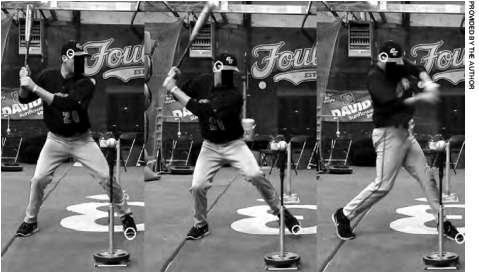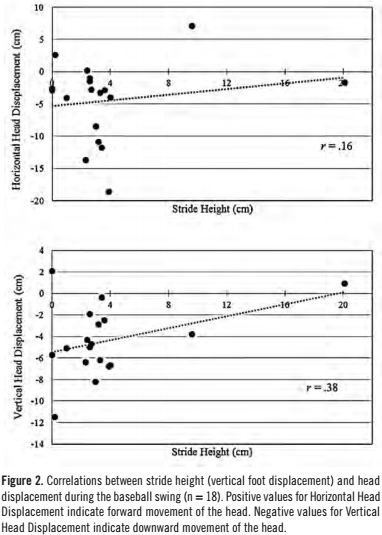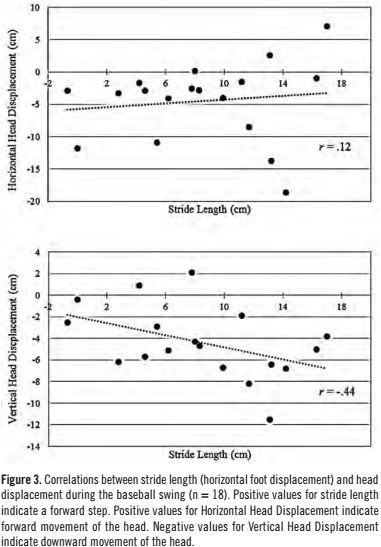Baseball Swing Stride and Head Movement Relationships
This article was written by Samuel J. Haag
This article was published in Fall 2017 Baseball Research Journal
Abstract
Some have suggested that a baseball batter must keep their head still in order to visually track a pitched baseball, and that striding with the front foot during the swing leads to excessive head movement and disrupts the tracking of the pitch. However, previous research has shown the head does move during the swing, and striding with the front foot contributes to weight transfer and timing of the swing. The author is aware of no research that has examined the relationship between head movement and stride foot movement during the baseball swing. The present study analyzed the swings of 18 collegiate baseball players using a video camera and two-dimensional motion analysis program. No meaningful correlations were found between movements of the head and stride foot in either the vertical or horizontal axes. These findings suggest striding with the front foot is not associated with head movement and support the notion that a stride can be a beneficial component of a baseball swing.
Introduction
The task of hitting a baseball has been identified as one of the most difficult skills in sports, and numerous instructions are employed to aid performance.1 One such instruction is for baseball batters to use a minimal stride with the front foot when performing the baseball swing. Several research studies have examined the role of the stride in the baseball swing. Smith suggests overstriding produces excessive head movement, changing the batter’s eye level and making it more difficult to judge the pitch.2 Fortenbaugh et al. argue the most common approach for a baseball batter is to initially load the body’s weight toward the back foot and raise the front foot off the ground, and striding with the front foot then promotes proper timing and weight shift during the swing.3 Katsumata states that striding plays a role in fixing the front foot on the ground for rotation of the hip and upper body, thus transferring force from the lower body to the upper body when executing the swing.4
But while the baseball swing has received considerable attention in the research literature, relatively few studies have analyzed head movement during the baseball swing. Welch et al. provide a detailed description of the biomechanics of the baseball swing after testing 39 professional baseball players but do not include measures of stride height or head movement.5 Using a multi-camera video analysis, Inkster et al. have studied the kinematics of the baseball swing in 20 experienced Australian baseball players and found participants tended to lower their head about 9 cm on average during the baseball swing.6 A comparison study of eight skilled baseball players and nine novices by Nakata et al. analyzed head movement in both the horizontal and vertical axes with three high speed video cameras.7 They found no significant differences in vertical head movement between the two groups, and the average amount of vertical head movement was similar to that reported by Inkster et al. Nakata et al. did find that skilled players demonstrated more head movement in the horizontal axis (toward the pitcher) and their head movements were more stable (less variable) than the novices. In a related study, Mann et al. examined the head movements and visual gaze of four experienced cricket batters. They conclude that skilled batters possess a superior ability to couple the direction of their head to the movement of the ball, and argue that head movement may be needed to keep a target in a consistent frame of reference.8
While it is commonly thought that elite athletes maintain a still head during hitting actions, the available (though limited) research to date shows the head does move during the baseball swing.9 Even though some baseball coaches and hitting instructors may encourage batters to minimize their stride to keep the head still, the association between movement of the stride foot and the head during the baseball swing has not been thoroughly studied. This anecdotal suggestion may be hindering the swing mechanics of players that would normally rely on a stride for proper weight shift and timing. Therefore, the purpose of the present study was to examine the relationship between stride foot movement and head movement during the baseball swing. Since this study was exploratory in nature, it was hypothesized that movement of the head would not be correlated with movement of the stride foot during the swing. Greater understanding of this relationship could help enhance baseball batting performance and allow coaches and instructors to provide the most accurate information for their players.
Methods
Participants
Eighteen members of a National Collegiate Athletic Association (NCAA) Division II baseball team participated in the study. Since the participants were experienced collegiate players, it was assumed they would each demonstrate a consistent baseball swing. The average age for the group was 20.1 years (SD = 1.1 years), with an average height of 1.82 m (SD = .05 m) and average weight of 85.6 kg (SD = 9.8 kg). Fourteen of the participants batted right-handed, and four batted left-handed. Each participant was free from injury and completed a consent form prior to the study.
Procedures
During an organized team practice in an indoor facility, participants performed five swings at a baseball placed on a batting tee at the height of each participant’s waist. Participants were instructed to perform a normal swing to make solid contact on each trial, and each participant used his own bat.
A digital video camera recording at 60 frames per second was positioned on a tripod about 3.8 m from the tee, providing a side view of the swing. Pieces of white tape (2 cm by 2 cm) were placed on the anterior aspect of the participant’s stride (front) foot and on the lateral aspect of the participant’s hat facing the camera to serve as markers for motion analysis (see Figure 1). Each participant completed the trials in about two to three minutes. All procedures were approved by a university institutional review board.
Figure 1: Phases of the baseball swing from initiation to ball contact. Foot and head landmarks used for motion analysis are circled. Click image to enlarge.
Video Analysis
Video recordings were analyzed with a personal computer using Kinovea, an open-source video analysis software program that has been employed in previous kinematic studies.10 A two-dimensional coordinate system was used to measure the change in position of the head and foot landmarks in both the vertical and horizontal axes. The coordinate system was calibrated by using the length of the base of the batting tee as a reference line. This calibration was done separately for each video file.
Vertical and horizontal head displacement measures were calculated as the difference between the respective coordinates of the head marker at initiation of the swing and at ball contact. Likewise, horizontal foot displacement (stride length) was calculated as the difference between the horizontal coordinates of the foot marker at initiation of the swing and at ball contact. Vertical foot displacement (stride height) was calculated as the difference between the vertical coordinate of the foot marker at initiation of the swing and at the foot’s highest position during the swing. The displacement measures were deemed reliable, as coefficient alpha values were greater than .90 when comparing two consecutive trials. Each of the displacement measures for the head and foot were averaged across the five trials for each participant.
Statistical Analysis
Pearson correlation coefficients were calculated to determine the magnitude of the associations between the average head and foot displacement measures. With 18 participants and alpha = .05, a Pearson r ≥ .47 would be required to be considered statistically significant.11 Effect sizes were interpreted according to Cohen’s criteria: .10 = small, .30 = moderate, .50 = large. Statistical tests were computed using SPSS 19.
Results
For the 18 participants, average head movement during the swing was about 4.4 cm downward (SD = 6.2 cm) and 4.5 cm backward (SD = 3.3 cm). Average stride length during the swing was about 8.5 cm forward (SD = 5.2 cm), and the average stride height was about 3.7 cm (SD = 4.6 cm). Stride height was not significantly correlated with head displacement in either the horizontal (r = .16) or vertical axis (r = .38) during the baseball swing. (See Figure 2.) Likewise, stride length was not significantly correlated with head displacement in either the horizontal (r = .12) or vertical axis (r = -.44; see Figure 3). Overall, displacement of the head was not associated with displacement of the stride foot during the baseball swing.
Figure 2
(Click image to enlarge)
Figure 3
(Click image to enlarge)
Discussion
While keeping the head still is often recommended for baseball batters, the head does move during the swing.13 Despite this evidence, baseball coaches and instructors may advise against using a stride because they believe it causes excessive head movement and interferes with visual perception of the pitch. As the author could locate no prior research that specifically addressed this issue, the present study examined the relationship between stride foot movement and head movement during the baseball swing in collegiate baseball players.
No meaningful correlations were found between movements of the head and stride foot during the baseball swing, supporting the author’s hypothesis. Even though the correlation between stride height and vertical head displacement could be considered moderate according to Cohen’s criteria, a closer examination of the data shows that the direction of the correlation was in the opposite direction of what might be expected by those who believe striding results in additional movement of the head.14 Many of the participants that displayed the greatest amount of vertical head displacement actually had minimal or no height in their stride, while the participant with the highest stride showed almost no vertical head displacement (see Figure 2). The correlation between stride length and vertical head displacement could also be considered moderate, which may indicate that those with a longer stride during the swing may also exhibit greater vertical displacement of the head (see Figure 3). However, this correlation only demonstrates 19% common variance between the two variables.
Mann et al. proposed coupling head movement to movement of the ball may be an important element in interceptive tasks like baseball batting.15 In the present study, head movement was observed during the swing, which is consistent with previous research.16 Head movement was highly variable between players, as standard deviations were relatively large, especially in the vertical axis. Additionally, while most players displayed downward and backward displacement of the head during the swing, three players moved their head forward and two players moved their head upward. The high degree of variability between participants demonstrates that each player has acquired an individualized movement pattern that involves coordinating his head movement with the rest of the swing.
As this was a pilot study meant to spur further investigation in a relatively unstudied area, several limitations were present. First, since a batting tee was used, this study can’t account for changes in the baseball swing resulting from different pitch speeds and types. Fortenbaugh et al. compared the ground reaction forces produced by 29 minor league baseball players when swinging at fastballs and changeups.17 They found baseballs pitched at slower speeds (changeups) produced significant changes in the timing of the swing and the braking forces of the front foot, though the initial loading mechanism of the swing was not affected. While different pitch speeds can influence certain aspects of the baseball swing, other studies have utilized a tee, and an intention of the present study was to maintain a consistent swing pattern across trials.18 Second, since the main focus of this study was the overall height and length of the stride, foot and head movement were not measured throughout the swing. Rather, vertical and horizontal positions of the head and foot were measured at the initiation of the swing, at the highest point of the stride (if one occurred), and at ball contact. A more sophisticated motion analysis system would provide more specific measurements of head and foot movement throughout the swing. For example, several groups of researchers have performed three-dimensional motion analysis using multiple cameras.19 It should be noted, however, that research on head movement during swinging skills is limited, and there is not an established definition for keeping a “still head” during this type of skill.20 Finally, while some studies have asked participants to perform 10 or more swings, the number of trials in this study was chosen to minimize interruption of the team’s practice while still providing multiple trials for each participant.21 It can also be noted that Welch et al. measured only three swings for each participant in their biomechanical study of the baseball swing and Inkster et al. included data from only the best five swings for each participant in their analysis.22 While some aspects of this study may limit its generalizability to the larger population of baseball players in general, the results are still useful for baseball coaches, instructors, and players.
Conclusions
The present findings suggest stride height and stride length are not associated with displacement of the head during the baseball swing in experienced collegiate baseball players. Head movement during the baseball swing may be beneficial if it is purposeful and consistent. Researchers should continue to examine head movement and its coupling with visual perception during the baseball swing. Future research in this area should also include participants of varying skill level, as several studies have shown differences in swing mechanics when comparing skilled and unskilled players. Other outcome measures such as bat velocity could also be considered. Current research evidence indicates baseball batters can be encouraged to use a stride provided it doesn’t interfere with their balance and swing mechanics. An efficient stride can be an essential element of a proficient baseball swing.
SAMUEL J. HAAG is an assistant professor of Kinesiology and Health Sciences at Concordia University, St. Paul. He received his B.S. in Physical Education-Exercise Science from Southwest Minnesota State University (2006), M.S. in Human Performance-Applied Sport Science from the University of Wisconsin-La Crosse (2008), and Ph.D. in Kinesiology from the University of Minnesota (2011). His research examines various aspects of motor performance in sport and physical activity. He is a member of the American College of Sports Medicine and the North American Society for the Psychology of Sport and Physical Activity.
Acknowledgements
This research was supported by a Faculty Development Grant from Concordia University, St. Paul. Findings from this research were presented by the author in a poster session at the 18th International Conference on Perception and Action in Minneapolis.
Notes
- Dave Fortenbaugh, “The Effect of Pitch Type on Ground Reaction Forces in the Baseball Swing,” Sports Biomechanics 10, no. 4 (2011): 270–9; Hiroki Nakata, “Differences in the Head Movement During Baseball Batting Between Skilled Players and Novices.” Journal of Strength and Conditioning Research 26, no. 10 (2012): 2632–40. An Internet search for “baseball batting stride” conducted by the author produced hundreds of thousands of results with myriad observations and recommendations, but no clear consensus on how the stride affects batting.
- Brian Smith, “Getting a Head Start in the Batting Stance.” Coach & Athletic Director 68, no. 8 (1999): 20.
- Fortenbaugh, “The Effect of Pitch Type.…”.
- Hiromu Katsumata, “A Functional Modulation for Timing a Movement: A Coordinative Structure in Baseball Hitting.” Human Movement Science 26 (2007): 27–47.
- Christian Welch, “Hitting a Baseball: A Biomechanical Description.” Journal of Orthopaedic & Sports Physical Therapy 22, no. 5 (1995): 193–201.
- Brendan Inkster, “Differences in Kinematics of the Baseball Swing Between Hitters of Varying Skill.” Medicine & Science in Sports & Exercise 43, no. 6, (2011): 1050–4.
- Nakata, “Differences in the Head Movement…”.
- David Mann, “The Head Tracks and Gaze Predicts: How the World’s Best Batters Hit a Ball.” PLoS ONE 8, no. 3 (2013): e58289. Accessed September 7, 2014. doi: 10.1371/journal.pone.0058289.
- Ibid.; Nakata, “Differences in the Head Movement…”; Inkster, “Differences in Kinematics of the Baseball Swing…”.
- Joan Charmant, Kinovea (Version 0.8.15) [Software]. Available from http://www.kinovea.org/; Carlos Balsalobre-Fernandez, “The Concurrent Validity and Reliability of a Low-Cost, High-Speed Camera-Based Method for Measuring the Flight Time of Vertical Jumps.” Journal of Strength & Conditioning Research 28, no. 2 (2014): 528–33; Matthew Barr, “Sprinting Kinematics of Elite Rugby Players.” Journal of Australian Strength and Conditioning 21, no. 4 (2013): 14–20.
- William Vincent, Statistics in Kinesiology (4th ed.). Champaign, IL: Human Kinetics, 2012.
- Jacob Cohen, Statistical Power Analysis for the Behavioral Sciences (2nd ed.). Hillsdale, NJ: Lawrence Erlbaum Associates, Inc., 1988.
- Nakata, “Differences in the Head Movement…”; Inkster, “Differences in Kinematics of the Baseball Swing…”.
- Cohen, Statistical Power Analysis for the Behavioral Sciences.
- Mann, “The Head Tracks and Gaze Predicts.”
- Nakata, “Differences in the Head Movement…”; Inkster, “Differences in Kinematics of the Baseball Swing…”.
- Fortenbaugh, “The Effect of Pitch Type.…”.
- Christian Welch, “Hitting a Baseball”; Inkster, “Differences in Kinematics of the Baseball Swing…”.
- Nakata, “Differences in the Head Movement…”; Inkster, “Differences in Kinematics of the Baseball Swing…”.; Christian Welch, “Hitting a Baseball.”
- Mann, “The Head Tracks and Gaze Predicts.”
- Fortenbaugh. “The Effect of Pitch Type.….”; Nakata, “Differences in the Head Movement…”; Inkster, “Differences in Kinematics of the Baseball Swing…”.
- Christian Welch, “Hitting a Baseball,” 193–201; Inkster, “Differences in Kinematics of the Baseball Swing…”.
- Nakata, “Differences in the Head Movement….”; Inkster, “Differences in Kinematics of the Baseball Swing…”.





